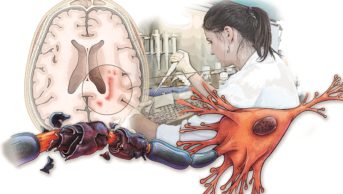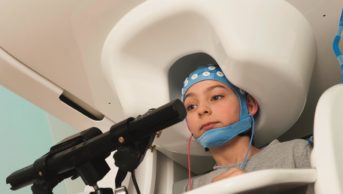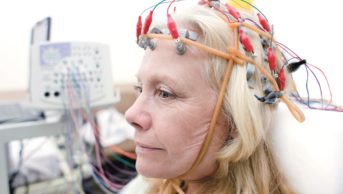
Danita Delimont / Alamy
In short
Amyotrophic lateral sclerosis is a progressive, fatal neurodegenerative condition that affects both the upper and lower motor neurons. The median survival time after diagnosis is three to five years.
The only treatment, riluzole, extends life expectancy by months. Pharmacological management focuses on symptom management, with a particular focus on relieving excess salivation, breathlessness and malnutrition.
Amyotrophic lateral sclerosis (ALS), also known as Lou Gehrig’s disease, affects around 2,000 people each year in England and Wales, with a peak age of onset between 50 years and 70 years[1]
.
ALS is the most common disease of the anterior horns of the spinal column, which hold the nerve roots responsible for control of the muscles of the trunk or head. It causes progressive deterioration of both the upper motor neurons of the corticospinal tract, which conduct impulses from the brain to the spinal cord, and the lower motor neurons, which carry the impulses from the corticospinal tract to the individual muscles.
Previously, the terms motor neurone disease and ALS have been used interchangeably. However, the term motor neurone disease refers to a collection of five different disorders, which also includes progressive muscular atrophy and progressive bulbar palsy[2]
.
Symptoms
Upper motor neuron symptoms of ALS include hyperreflexia (overactive reflexes), clonus (involuntary, rhythmic muscle contraction and relaxation) and spasticity. Lower motor neuron symptoms include weakness, wasting and fasciculation (muscle twitches).
Onset of symptoms is insidious and gradual, and ALS often starts asymmetrically, affecting a single nerve root which presents as limb weakness or, if the bulbar region is affected, as dysarthria (difficulty speaking) or dysphagia (difficulty swallowing). Eventually, the disease progresses to affect all the motor roots of the body. The speed of disease progression varies considerably between patients[3]
.
Cognitive impairment and dementia-like symptoms, typically related to frontotemporal executive dysfunction, occur in up to 50% of ALS patients. Parkinsonian symptoms, facial masking, tremor and postural instability may also develop[4]
. Without treatment, symptoms progress until the patient dies, usuallu because of respiratory failure or dysphagia.
The median survival time after diagnosis is three to five years[5]
. However, around 10% of ALS patients live at least 10 years after diagnosis. Survival beyond 20 years is rare[5]
.
Causes
The cause of ALS is unknown in the majority of cases. Around 10% of cases have a genetic link.
The most common disease-causing mutation occurs in the superoxide dismutase (SOD1) gene, although other mutations have been identified[6]
. The dysfunctional SOD1 enzyme forms a complex with copper and zinc ions within the mitochondria, leading to protein unfolding and aggregation. This accumulation disrupts the mitochondrial membrane potential and acts as a catalyst for further mitochondrial dysfunction. Cellular adenosine triphosphate (ATP) production is decreased and calcium homeostasis is disturbed, triggering apoptosis and leading to cell death[7]
.
Symptom control
There is currently no cure for ALS. Treatment focuses on supportive care provided by a multidisciplinary team, working with the patient and caregivers to keep the patient as comfortable as possible in response to symptoms[5]
. This ranges from the supply of specialist equipment to enable everyday living, through to the introduction of feeding tubes and respiratory support. Pharmacological interventions are mostly aimed at controlling symptoms.
Salivation
Problems with salivation are common, particularly sialorrhoea (excessive salivation). Supportive treatment depends upon the nature of the secretion.
If the saliva is excessive and thin, the first-line treatment is hyoscine, usually via a transdermal patch. Other options include the tricyclic antidepressant amitriptyline, which has an antimuscarinic effect, or atropine 0.5% eye drops applied directly onto the patient’s tongue. If salivation continues to be a problem, some specialist centres use botulinum A (Botox), which is injected directly into the salivary glands[8]
.
If the saliva is considered to be too thick, carbocisteine is used to help thin the secretions. Patients should also increase their fluid intake and avoid alcohol and caffeinated drinks, or suck hard-boiled sweets to stimulate the salivary glands.
Respiratory care
As the muscles of the respiratory system become affected, sudden attacks and shortness of breath become more frequent. Diaphragm weakness can result in nocturnal hypoventilation, which presents as morning headaches, fatigue, poor appetite, broken sleep or excessive tiredness.
Breathlessness can be managed with low-dose opioids (e.g. 2.5mg morphine sulphate liquid) or a low-dose dispersible benzodiazepine (e.g. lorazepam). This may be provided to patients in ‘rescue packs’, with patients advised to suck on the dispersible tablet until the breathlessness subsides[9]
.
Non-invasive nocturnal ventilatory support is used in patients with significant respiratory problems.
Patients with ALS should be offered influenza and pneumococcal vaccinations to reduce the risk of respiratory illness[9]
.
Malnutrition
Malnutrition is another common problem in patients with ALS. This can be caused either by the patient not eating sufficiently or mechanical problems with swallowing. Patients with malnutrition should be referred to a dietitian, who can ensure appropriate nutritional supplements and dietary aids are prescribed[10]
.
Riluzole
Riluzole, an antiglutaminergic, is the only disease-modifying agent currently licensed for use in ALS[2]
. Riluzole reduces damage to motor neurons by decreasing the release of glutamate, which reduces glutamate receptor stimulation and helps to regulate intracellular calcium concentrations in the neuron[11]
. This prevents the initiation of apoptosis by mitochondria sensitive to high calcium levels. Riluzole does not reverse damage already done to motor neurons.
The National Institute for Health and Care Excellence (NICE) recommends riluzole should only be initiated by a neurology specialist, following a complete assessment of a patient’s symptoms. It is taken orally as one 50mg tablet twice a day.
Riluzole tablets should be swallowed whole, although the tablets can be crushed and mixed with soft food for patients with difficulty swallowing. Crushed tablets should be taken immediately because of stability problems. Riluzole does not dissolve well in water, and should not be administered by a percutaneous endoscopic gastronomy (PEG) feed as it may block the tubing[10]
.
The most common side effects of riluzole are weakness, dizziness, diarrhoea and abdominal pain[11]
. Riluzole may cause liver damage, and should be used with caution in patients with a history of abnormal hepatic function. Other side effects include interstitial lung disease and neutropenia, and patients should be advised to seek immediate medical attention if symptoms such as fever occur.
NICE recommends patients taking riluzole have monthly liver function tests. A full blood count should be performed on initiation of therapy, and repeated monthly for three months, then three-monthly for the first year, then annually.
The estimated annual cost of treatment with riluzole is around £3,742, including the costs of monitoring[2]
.
Patients most likely to benefit from treatment with riluzole include those who: have symptoms present for less than five years; have a vital lung capacity greater than the 60% predicted; do not require a tracheotomy and in whom other causes of progressive muscle atrophy have been ruled out. Unfortunately, the effects of riluzole on disease progression are modest, and increased survival time is measured in months rather than years[12]
.
Future ALS treatment options
A range of other treatment options for ALS have been explored, including alternative glutamate antagonists, antiapoptotic agents and antioxidants.
Trials involving the use of antisense oligonucleotide therapy for SOD1-associated familial ALS, retigabine and tocilizumab are showing some promise, although these are still ongoing.
Patrick Russell is a care of the elderly pharmacist and Richard Harrison is a respiratory consultant, both at North Tees and Hartlepool Foundation Trust.
References
[1] Logroscino G, Traynor BJ, Hardiman O et al. Incidence of amyotrophic lateral sclerosis in Europe. J Neurol Neurosurg Psychiatry 2010;81:385–390 doi:10.1136/jnnp.2009.183525.
[2] National Institute for Health and Care Excellence. Guidance on the Use of Riluzole (Rilutek) for the Treatment of Motor Neurone Disease:NICE technology appraisals [TA20]. NICE. 2001. (updated March 2010).
[3] Ravits J, Paul P & Jorg C. Focality of upper and lower motor neuron degeneration at the clinical onset of ALS. Neurology 2007;68:1571.
[4] Ringholz GM, Appel SH, Bradshaw M et al. Prevalence and patterns of cognitive impairment in sporadic ALS. Neurology 2005;65:586.
[5] McDermott CJ & Shaw PJ. Diagnosis and management of motor neurone disease. BMJ 2008 336:658–662.
[6] De Vos KJ, Chapman AL, Tennant ME et al. Familial amyotrophic lateral sclerosis-linked SOD! mutant perturbs fast axonal transport to reduce axonal mitochondria content. Hum Mol Genet 16;3720–2728.
[7] Tradewell M, Cooper LA, Minotti S et al. Calcium dysregulation, mitochondrial pathology and protein aggregation in a culture model of amyotrophic lateral sclerosis:mechanistic relationship and differential sensitivity to intervention. Neurobiol Dis 2011;42:265–275.
[8] Hopcutt B and Alnufoury H. Sialorrhea Treatment Algorithm for MND [Online]. Available from: www.mndassociation.org.
[9] Allcroft P. Breathlessness in motor neurone disease: a review of the current strategies and gaps in the evidence. Current Opinion in Supportive & Palliative Care 2014 8;3:213–217.
[10] Heffernan C, Jenkinson C, Holmes T et al. Nutritional management in MND/ALS patients:an evidence based review. Amyotrophic Lateral Sclerosis 2004 5;2:72–78.
[11] Miller RG, Mitchell JD & Moore DH. Riluzole for amyotrophic lateral sclerosis (ALS) motor neurone disease (MND). Cochrane Database Syst Rev 2012 Mar 14;3:CD001447.
[12] Miller RG, Jackson CE, Kasarskis EJ et al. Practice parameter update: the care of the patient with amyotrophic lateral sclerosis: drug, nutritional, and respiratory therapies (an evidence-based review): report of the Quality Standards Subcommittee of the American Academy of Neurology. Quality Standards Subcommittee of the American Academy of Neurology . Neurology 2009;73:1218.


